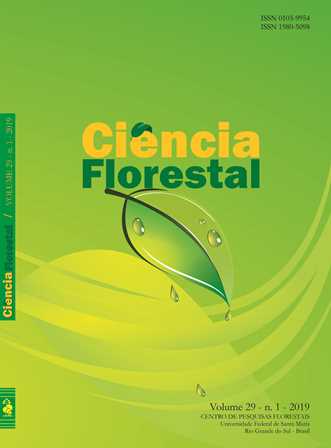Clustering of Amazon wood species based on physical and mechanical properties
DOI:
https://doi.org/10.5902/1980509828114Keywords:
Indication of species, Tropical wood, Wood technologyAbstract
The intense search for consolidated native wood essences, which are highly used, can lead to the overexploitation of species and decrease their stocks in the forest. An alternative to this situation is the replacement of these species by others with similar wood properties and with sufficient forest growing stock. The objective of this work was to cluster the Amazon species through wood physical-mechanical properties and perform the discriminant analysis to identify which technological characteristics are more important for the clustering. The species studied came from eight different locations in the Amazon region. The properties used were: basic density, contraction (tangential, radial and volumetric), static flexion, compression parallel and perpendicular to the fibers, Janka hardness parallel and transversal, traction perpendicular to the fibers, cracking and shearing, all obtained from the national specialized literature. Multivariate Cluster analysis (simple Euclidean distance and Ward’s method) and the discriminant analyses were used to evaluate the clustering. Cluster analysis was efficient to cluster the species, which were separated into three distinct groups. The species that stood out were Helicostylis pedunculata Benoist. and Tachigali chrysophylla (Poepp.) Zarucchi & Herend., f or clustering with the most commercialized species. The lowest values of Wilks’Lambda were wood density (0.759053), shearing (0.802960) and compression parallel to the fibers (0.825594). These characteristics were the most determinant to discriminate the clusters. The clustering analysis was efficient for the separation of the species into marketing clustersDownloads
References
ABRUZZI, R. C. et al. Relação das propriedades mecânicas e densidade de postes de madeira de eucalipto com seu estado de deterioração. Revista Árvore, Viçosa, v. 36, n. 6, p. 1173 -1181, 2012.
ADEODATO, S. et al. Madeira de ponta a ponta: o caminho desde a floresta até o consumo. São Paulo: FGV ERA, 2011. 128 p.
ARMSTRONG, J. P.; SKAAR, C.; ZEEUW, C. The effect of specific gravity on several mechanical properties of some world woods. Wood Science and Technology, [s.l], v. 18, n. 2, p. 137-146, 1984.
BURGER, L. M.; RICHTER, H. G. Anatomia da Madeira. São Paulo: Nobel. 1991. 154 p.
FAVERO, L. P. et al. Análise de dados: modelagem multivariada para tomada de decisões. Rio de Janeiro: Elsevier. 2009. 368 p.
INSTITUTO BRASILEIRO DE DESENVOLVIMENTO FLORESTAL (IBDF). Madeiras da Amazônia: características e utilização-Floresta Nacional do Tapajós. v.1, Brasília: CNPq. 1981. 113 p.
INSTITUTO BRASILEIRO DE DESENVOLVIMENTO FLORESTAL (IBDF). Madeiras da Amazônia: características e utilização-Estação Experimental de Curuá-Una. v.2, Brasília: DPq-LPF. 1988. 236 p.
INSTITUTO BRASILEIRO DE GEOGRAFIA E ESTATÍSTICA (IBGE). Mapa de biomas e vegetações. 2004. Disponível em: http://www.ibge.gov.br/home/presidencia/noticias/21052004biomashtml.shtm# sub_pesquisa> Acesso em: 20 set. 2016.
INSTITUTO BRASILEIRO DO MEIO AMBIENTE E DOS RECURSOS RENOVÁVEIS (IBAMA). Madeiras da Amazônia: características e utilização. v.3, Brasília: IBAMA. 1997. 141 p.
LENTINI, M.; VERÍSSIMO, A.; PEREIRA, D. A Expansão Madeireira na Amazônia. Instituto do Homem e Meio Ambiente da Amazônia. Belém: IMAZON, 2011. Disponível em: <http://www.imazon.org.br/publicacoes/o-estado-da-amazonia/a-expansao-madeireira-na-amazonia-1>. Acesso em: 20 set. 2016.
LABORATÓRIO DE PRODUTOS FLORESTAIS (LPF). Madeiras Brasileiras, 2016. Disponível em: http: // sistemas. florestal.gov.br/ madeirasdobrasil/ caracteristicas.php?ID=80&caracteristica=271 > Acesso em: 10 out. 2016.
LOPES, C. A. C. et al. Propriedades físico-mecânicas e usos comuns de 30 espécies de madeiras da Amazônia. Belém: SUDAM, 1983. 97 p.
MARIO, P. C. Análise discriminante In: CORRAR, L. J.; PAULO, E.; DIAS FILHO, J. M. A. Análise multivariada: para o curso de administração, ciências contábeis e economia. São Paulo: Atlas, 2014. p. 432-459.
MINGOTI, S. A. Análise de dados através de métodos de estatística multivariada: uma abordagem aplicada. Belo Horizonte: UFMG, 2005. 297 p.
MORAES NETO, S. P. et al. Propriedades mecânicas da madeira de cinco procedências de Pinus caribaea var. hondurensis implantadas no cerrado do Distrito Federal, DF. Boletim de pesquisa e desenvolvimento 251, Planaltina, DF: Embrapa Cerrados, 20p. 2009.
PROTASIO, T. P. et al. Correlações entre as propriedades físicas e mecânicas de painéis aglomerados de diferentes espécies de Eucalyptus. Floresta e Ambiente, Seropédica, v. 19, n. 2, p. 123 - 132, 2012.
REIS, P. C. M. R. Análise estrutural e propriedades tecnológicas da madeira de espécies da Amazônia. 2017. 81 f. Tese (Doutorado em Ciência Florestal) – Universidade Federal de Viçosa. Viçosa, 2017.
SECRETARIA DE MEIO AMBIENTE E SUSTENTABILIDADE (SEMAS-PA). Comercialização Total por Destino das Vendas: 2015. Disponível em:<http://monitoramento.sema.pa.gov.br/sisflora/index.php
/relatorios>. Acesso em: 20 set. 2016.
SOUZA, A. L.; SOARES, C. P. B. Florestas nativas: estrutura, dinâmica e manejo. Viçosa: UFV, 2013. 322 p.
SOUZA, A. L.; SOUZA, D. R. Análise multivariada para estratificação volumétrica de uma Floresta Ombrófila Densa de Terra Firme, Amazônia Oriental. Revista Árvore, Viçosa, v. 30, n.1, p. 49-54, 2006.
STASOFT INC, 2016. StatSoft. Stat. Data Anal. Softw. Syst. 13. URL http://www.statsoft.com/
UETIMANE JUNIOR, E.; ALI, A. C. Relationship between mechanical properties and selected anatomical features of Ntholo (Pseudolachnostylis maprounaefolia). Journal of Tropical Forest Science, [s.l], v. 23, n. 2, p. 166–176, 2011.







